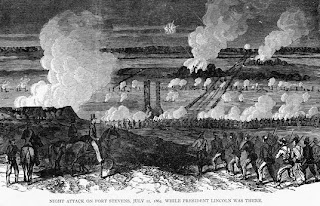Fort Stevens (near Georgia Avenue at 13th Street and Quackenbos Street NW) is the place where President Abe Lincoln came under fire during the Civil War and where approximately 900 soldiers were killed, wounded or reported missing.
The Fort was part of the extensive fortifications built around Washington, D.C., during the American Civil War. Constructed in 1861 as "Fort Massachusetts", it was later enlarged by the Union Army and renamed "Fort Stevens" after Brig. Gen. Isaac Ingalls Stevens, who was killed at the Battle of Chantilly, Virginia, on September 1, 1862.
Gen. Isaac Ingalls Stevens. He was killed in action at the Battle of Chantilly after picking up the fallen regimental colors of his old regiment, shouting "Highlanders, my Highlanders, follow your general!" Charging with his troops while carrying the banner of Saint Andrew's Cross, Stevens was struck in the head by a bullet and died instantly. His son, Hazard, as also injured in the Battle of Chantilly. He also became a general in the U.S. Army and an author, and th first man to climb Mount Rainier.
Jubal Early
In June 1864, Gen. Jubal Early was dispatched by Gen. Robert E. Lee with the Second Corps of the Army of Northern Virginia from the Confederate lines around Richmond with orders to clear the Shenandoah Valley of Federals and then if practical, invade Maryland, disrupt the Baltimore and Ohio Railroad and if possible threaten Washington. The hope was that a movement into Maryland would force Union Lt. Gen. Ulysses S. Grant to send troops to defend Washington against the threat, thus reducing his strength to take the Confederate capital.
After easily driving off the Army of West Virginia under Maj. Gen. David Hunter at the short-lived Battle of Lynchburg on June 18, the Second Corps marched down the valley, entering Maryland on July 5 near Sharpsburg. They then turned east towards Frederick where they arrived on July 7.
Lew Wallace (Author of Ben Hur, and later Governor who pardoned Billy the Kid)
Two days later, as the Second Corps prepared to march on Washington, Maj. Gen. Lew Wallace leading a small rag-tag army, bolstered by the eleventh-hour addition of two brigades of the VI Corps sent from Richmond under Maj. Gen. James B. Ricketts, attempted to resist the Confederate advance at the Battle of Monocacy.
The battle lasted from about 8 a.m. until around 4 p.m., but ultimately Early's corps drove off the small Union force, which was the only substantial Union army between it and the capital. After the battle Early resumed his march on Washington, arriving at its northeast border near Silver Spring at around noontime on July 11. Because of the battle and then long march through stifling summer heat, and unsure of the strength of the Federal position in front of him, Early decided to not send his army against the fortifications around Washington until the next day.
Fort Stevens came under direct Confederate attack by troops led by Maj. Gen. Jubal Early (Of nearby Lynchburg, where he died at age 77 after falling down a flight of stairs) Maj. Gen. John C. Breckinridge, former U.S. vice president and one of Lincoln's opponents in the presidential election of 1860, was one of the Confederate commanders. Breckinridge was a cousin of Mary Todd Lincoln and a beau in her youth.
John C. Breckinridge
In the Battle of Fort Stevens on July 11 and July 12, 1864. President Abraham Lincoln rode out to the Fort with his wife Mary, and some officers rode out to observe the attack, and were briefly under enemy fire that wounded a Union surgeon standing next to Lincoln on the Fort Stevens parapet. On both days he was there to observe the attack, Lincoln was briefly under enemy fire by sharpshooters.
On July 12, he was brusquely ordered to take cover, mostly likely by Union Maj. Gen. Horatio Wright (Legend says that future Supreme Court Justice Oliver Wendell Holmes Jr., then an aide-de-camp to Wright, yelled at Lincoln, "Get down, you fool!")
Oliver Wendell Holmes Jr
The incident was the second time in American history that a sitting president came under enemy fire during a war, the first being President James Madison during the War of 1812.
The skirmishing continued into July 12, until Early finally decided Washington could not be taken without heavy losses too severe to warrant the attempt. His corps withdrew that evening, headed back into Montgomery County, Maryland, and crossed the Potomac River on July 13 at White's Ferry into Leesburg, Virginia. Early remarked to one of his officers after the battle, "Major, we didn't take Washington but we scared Abe Lincoln like hell."
Although no visible evidence of the original fort remains, the partial reconstruction of Ft. Stevens that survives today done by the Civilian Conservation Corps in 1937. The remains of 41 Union soldiers who died in the Battle of Fort Stevens are buried on the grounds of nearby Battleground National Cemetery.











